They may look pretty but they can quietly dominate our beautiful meadows and forests.
Managing noxious weeds improves your property, your neighbor’s property and shared
space.
Noxious weeds are non-native plants, usually from Europe or Asia, that have no natural
predators or diseases to keep them in check. They are invasive, capable of displacing
native vegetation and turning a productive ecosystem into a monoculture of weeds. In
1992, the Colorado General Assembly passed the Colorado Noxious Weed Act that
requires each county to adopt a weed management plan. El Paso County developed a
county-wide weed plan El Paso County Weed Plan . Each property owner has the
responsibility to help eliminate these weeds according to Colorado law. Some of the more common and abundant noxious weeds in TPR are listed and described below.
This information is from the Glacier View Meadows Ecology Committee website.
Noxious Weeds Found In Tall Pines Ranch
Canada Thistle
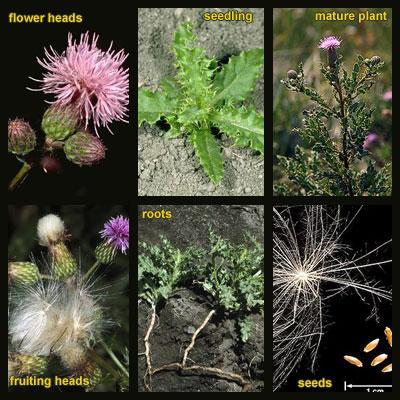
Canada thistle is a long-lived perennial that reproduces by roots which is how it produces large dense patches. The goal of Canada thistle treatment is to starve the extensive root system. It will take several years of persistence.
- Growth Habit: This perennial grows 3′ tall and occurs in clumps or patches.
- Flower: It is covered with 1/2″ to 3/4″ purple flowers.
- Reproduction – It reproduces very little by seed and primarily by rootstock. Root systems may be several feet deep.
These methods will ensure that no flowers will be produced and no seed set:
- Mow or clip plants as often as possible during the growing season
- It’s important to leave at least 9 leaves per stem (cut at a height of 8 inches or more to achieve)
- Bag and dispose of all clippings in order to minimize fire fuels.
- If possible, apply herbicide in early October
Cheatgrass
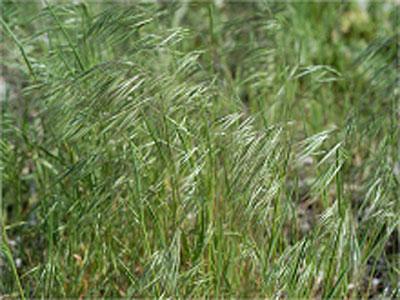
The term ‘cheatgrass’ is often used to describe various annual brome species. Locally, cheatgrass refers to downy brome and Japanese brome collectively, both species are found below 9,000 feet. Downy brome is the more prominent of the two grasses. Dense stands of dry plant material create a fine-fuel source for frequent summer wildfires in the western United States.
- Growth Habit: Cheatgrass species follow a winter annual life cycle – seed germinates following late summer or early fall moisture (some spring emergence can occur as well), becomes dormant in winter, and is the first grass to green-up in the spring. Cheatgrass typically sets seed in May and dries down by July. Cheatgrass proliferates following summer wildfires that eliminate desirable plants and create openings for cheatgrass emergence with late summer rains. Also, fire removes the thatch layer that can disrupt an herbicide’s effectiveness.
- Identification: Cheatgrass plants grow from 6 to 24 inches tall, depending on available soil moisture, fertility and plant competition. At emergence, leaves are brownish-green. Mature plants are red-brown in color and have erect and slender stems. Leaf sheaths and flat, twisting blades are covered with soft hair. Leaves are approximately 1⁄32 inch wide and 2 to 6 inches long. Panicles are 2 to 6 inches long with slender branches that droop to one side. It has numerous, five-to-eight-flowered spikelets with ⅜ to ⅝ inch awns that are slender, straight and purple at maturity. Each awn is attached to the lower lemma of a hairy, buffbrown, ½ inch long and narrow seed. Roots are fibrous, relatively shallow, and grow many hairs which enable the plants to extract soil water very effectively.
- Reproduction – At maturity, the abundant and very prickly seed heads become a nuisance to hikers, pets and livestock. Cheatgrass is a prolific seed producer. Seeds become germinable soon after maturation, but typically do not remain viable for more than two or three years.
A multi-year approach is generally needed.
- The most common herbicide for controlling cheatgrass is Imazapic (Plateau/Panoramic).
- Treatments should be applied in the fall either pre-emergent or early post emergent (prior to the tillering stage of the grass).
- Glyphosate (Roundup and others) can be applied at low rates in the winter when perennial grasses are dormant for selective control. It is safe to reseed with natural grasses within a week.
- No insect biocontrol agents are available for control of cheatgrass. Grazing in the early spring when the grass is palatable can suppress seed head production, but can also be injurious to desirable perennial grasses at that time.
- Hand pulling or tillage (where feasible) is effective if conducted prior to seed set. Mowing is marginally effective, as re-growth will occur and plants will set seed from a reduced height.
Several mitigation techniques can be used in conjunction with each other. For example, spray Imazapic in the fall as a pre-emergent to the seeds left behind after hand-pulling and mowing in the spring.
Resources:
Field Guide for Managing Cheatgrass in the Southwest – USDA Forest Service (pdf)
Downey Brome (cheatgrass) fact sheet – Colorado State (pdf)
Common Mullein
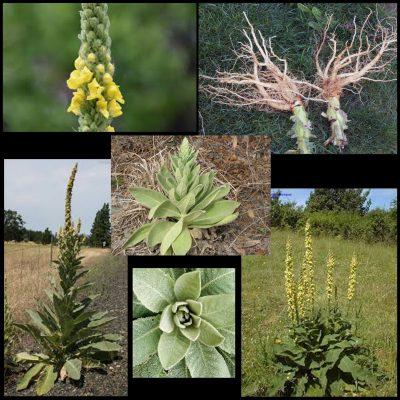
Mullein is an extremely common weed in TPR and the surrounding area. It is so abundant and seeds remain in the soil for so long that the state and county consider it the lowest priority. It should be treated only after more serious weeds are under control.
- Growth Habit: Common mullein is a biennial plant commonly found in disturbed areas of range and pasture. Common mullein seldom appears to have invasive characteristics except on heavily disturbed sites such as intensively grazed pastures, prairie dog colonies, or sites severely impacted by wildfire.
- Flower: Yellow flowers grow from a tall, solitary stalk that appears in mid-summer
- Leaves: Rosette of velvet-like leaves
- Reproduction – Common mullein seed germinates in the late summer or fall producing a rosette.
- The most effective herbicides for controlling common mullein are Escort, Milestone, and Telar when used with a good surfactant.
- There are no insect biocontrol agents available for control of common mullein.
- Hand pulling or digging this biennial is an effective method of control if the top 2-3 inches of tap root is removed.
Dalmation Toadflax
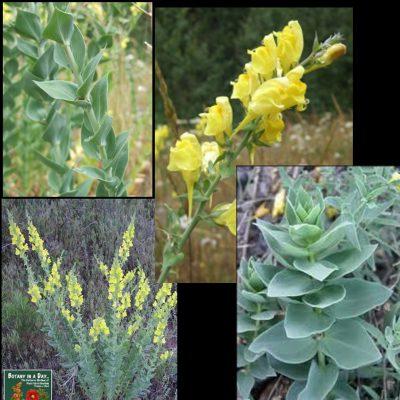
Dalmation Toadflax is an invasive type of snapdragon that was introduced by the horticulture industry.
- Growth Habit: This perennial has a hardy root system making it difficult to control.
- Flower: Flowers have the appearance of a yellow and orange snapdragon flower making it easy to identify.
- Leaves: Light green alternating, broad, heart-shaped leaves clasping the stem. Leaves are noticeably waxy.
- Reproduction – It reproduces both by a heavy production of seed and creeping roots.
- It can be weakened and ultimately controlled by vigilant, repeated clipping of the stalks throughout the growing season. This will starve the roots of nutrients and prevent plants from flowering or setting seed.
- It is best not to attempt to dig or pull this plant up as it will stimulate reproduction by roots.
Diffuse Knapweed
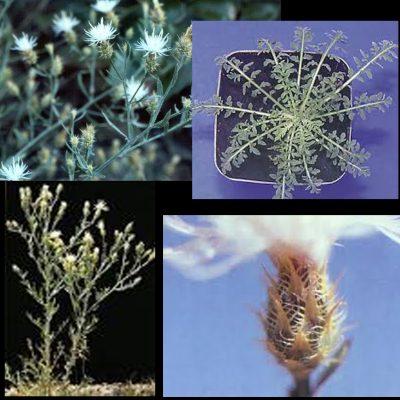
Diffuse knapweed is a biennial species that can sometimes live longer than 2 years and turn into a short-lived perennial. Spotted knapweed (C. stoebe ssp. micranthos) is very similar but with purple flowers. The two species hybridize producing plants with white and purple flowers on the same plant. Both are prolific seeders.
- Growth Habit: During the first year of growth, the plant appears as a low growing rosette of leaves. During the second year, Diffuse Knapweed grows into a 1 to 3 feet tall plant with many branches, blooming from June to September. This species is often accompanied by Spotted Knapweed and the two often hybridize.
- Flower: Small white flowers are found at the end of the branches and prickly spines surround each flower. Spotted knapweed has purple flowers and hybrids have both cream and purple flowers.
- Leaves: Greyish-green, alternating, basal leaves whorled and covered with fine hair. Upper leaves are much reduced.
- Impact – It has been discovered that the roots of this plant release a chemical which depresses growth of any other plant in its vicinity leading to an invasive monoculture of Diffuse Knapweed.
- Reproduction: It only reproduces by producing seeds
Control is through the cutting of the plant before the seeds are dispersed, or the rosettes can be dug up or sprayed with herbicide before they develop and produce seeds the second year. Control takes many years of persistence to succeed.
- Pull, dig or spray first year rosettes
- Monitor for new rosettes
- Pull, dig, mow or spray plants that are getting ready to bolt but not yet flowering
- Pull, clip or dig mature plants that have set seed however handle with great care. Place them into bags gently and dispose
Musk Thistle
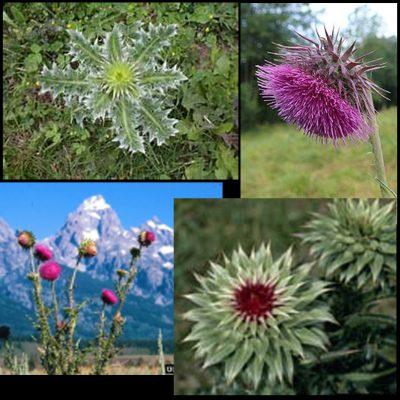
Musk thistle is a biennial which means it only lives for two years. The first year it presents itself as a rosette at ground level. The second year it bolts and sends up a tall flowering stalk with many purple flower heads. Whenever it is clipped or mowed it quickly regrows new flowers.
- Growth Habit: This weed is a biennial, which means that it appears only as a rosette the first year and as a flowering plant the second year. At maturity, it grows up to 7 feet tall.
- Flower: This thistle is also known as Nodding Thistle because the 1 to 3″ purple flowers found at the end of stems, tend to droop when mature. The bracts below the flower head are reflexed back.
- Leaves/Stems: Both the leaves and the stems are prickly. Leaves are usually edged with a grey or silver color.
- Reproduction: It does not have a massive root system and multiplies only by seed. Each plant can produce up to 10,000 seeds that are then dispersed by the wind
- Rosette Stage:
– Pull, dig or spray all rosettes when it first appears
– Spray with a herbicide - Prior to Flowering:
– Pull, dig or spray all bolting plants including roots - Once flowering has begun:
– Remove (clip) ALL seed heads and place in garbage bags for disposal.
– There is a high probability that herbicides will be ineffective. Remember musk thistle will die after flowering anyway
Caution: This thistle can be confused with the native Colorado Thistle, which has white flowers and blue-green foliage. This Colorado Thistle is NOT considered to be a noxious weed and need not be eradicated.






